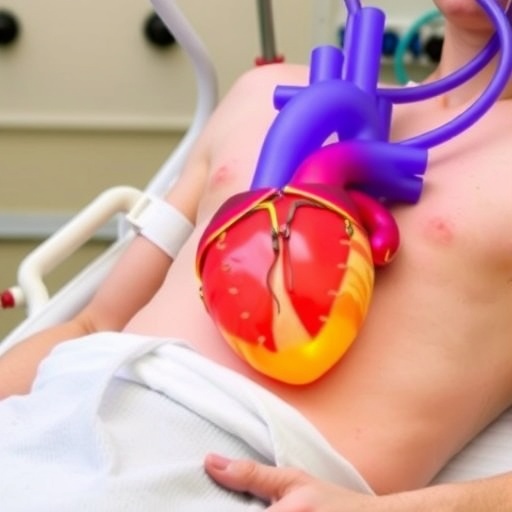In the relentless pursuit of effective obesity treatments, recent research has shed light on an innovative compound named SANA, a nitroalkene derivative of salicylate, which demonstrates unprecedented potential to stimulate energy expenditure through creatine-dependent thermogenesis. These findings open a new frontier in metabolic research, positioning SANA as a promising candidate for combating obesity, especially within thermoneutral environments where traditional thermogenic approaches often falter.
At the core of this breakthrough is the intricate modulation of creatine metabolism within adipose tissue. Adipose thermogenesis is traditionally understood as a process largely driven by uncoupling protein 1 (UCP1) in brown fat. However, growing evidence underscores an alternative, UCP1-independent thermogenic pathway dependent on creatine metabolism. Creatine-mediated cycling within fat cells results in sustained heat generation by dissipating energy through a substrate cycle. Importantly, previous disruptions in this pathway have been linked to reduced energy expenditure and an increased propensity for obesity, especially under thermoneutrality. SANA appears to uniquely harness and amplify this pathway, offering metabolic benefits without the cold stimulation requirement.
.adsslot_fYrUDhZoxS{ width:728px !important; height:90px !important; }
@media (max-width:1199px) { .adsslot_fYrUDhZoxS{ width:468px !important; height:60px !important; } }
@media (max-width:767px) { .adsslot_fYrUDhZoxS{ width:320px !important; height:50px !important; } }
ADVERTISEMENT
Detailed experimental models utilizing diet-induced obese (DIO) mice have revealed that administering SANA markedly protects against weight gain when animals are maintained at thermoneutral temperatures. Unlike many anti-obesity agents, SANA-treated mice did not reduce their food intake, indicating that its action relies primarily on increasing basal energy expenditure rather than appetite suppression. This subtle dissociation between intake and expenditure underscores a distinct mechanism of metabolic enhancement that could translate into unique clinical advantages, especially in terms of patient compliance and long-term sustainability.
Further validation of SANA’s thermogenic capacity was obtained through acute feeding regimens. When mice were subjected to a short high-fat diet challenge, no significant differences in weight gain appeared between treated and control groups. However, thermal imaging showcased a striking elevation in surface body temperature in SANA-treated subjects. These observations vividly demonstrate that SANA provokes an increase in heat dissipation independent of weight changes, solidifying the argument that its anti-obesity effects stem from enhanced thermogenic output rather than secondary weight fluctuations.
Metabolic measurements revealed that SANA boosts whole-body energy expenditure considerably during acute exposure to a high-fat diet. These changes manifest as elevated oxygen consumption and increased thermogenic activity, hallmarks of an engaged energy-dissipating system. Remarkably, this increase correlates with enhanced expression of creatine kinase enzymes within brown adipose tissue, integral components of the creatine-driven thermogenic cycle. Such molecular corroboration showcases that SANA’s effects are not superficial but embedded deeply within the biochemical machinery of thermogenesis.
In juxtaposition, administration of SANA to mice maintained on a normal chow diet did not yield changes in energy expenditure. This critical finding aligns with prior reports indicating that the activation of creatine metabolism in adipose tissue is contingent upon dietary stimuli such as high-fat content. Thus, SANA’s thermogenic stimulation is context-dependent, requiring a metabolic milieu that primes the adipose tissue for elevated energy turnover. This nuanced action hints at the potential for personalized therapeutic interventions, where SANA could be most effective in individuals exhibiting diet-induced metabolic stress.
Adding another layer to the mechanistic understanding, researchers examined the synergistic effect of SANA with β3-adrenergic stimulation. Administration of the β3-adrenergic agonist CL316,243, which transiently boosts thermogenesis, resulted in a significantly amplified energy expenditure in SANA-treated mice compared to controls. This enhancement persisted irrespective of body weight differences, as confirmed through rigorous statistical adjustments. The data suggest that SANA not only activates creatine-dependent pathways but may also prime adipose tissue responsiveness to classical adrenergic triggers, fostering a powerful combinatorial strategy to upregulate thermogenesis.
To decipher the molecular requirements underlying SANA’s function, investigators synthesized several analogues and isomers of the compound, altering the position of the nitroalkene functional group or extending the carbon chain. Testing these variants in acute high-fat diet models revealed that only the original SANA compound effectively induced thermogenic responses and elevated creatine kinase expression levels in brown adipose tissue. Therefore, the nitroalkene moiety’s precise location on the salicylate backbone is critical for biological activity, emphasizing the exquisite structure-activity relationship that governs these metabolic pathways. This insight provides a blueprint for future medicinal chemistry endeavors aimed at optimizing this therapeutic class.
The implications of this research stretch far beyond a single molecule. They further establish creatine-dependent thermogenesis as a bona fide target for obesity management, challenging the exclusive dominance of UCP1-centric models. By proving that small molecules like SANA can selectively invoke this alternative thermogenic route, the study opens avenues for developing safer, more effective metabolic therapies that harness endogenous pathways without relying on external stimuli such as cold exposure or intense physical activity.
Moreover, SANA’s ability to circumvent appetite suppression while enhancing energy expenditure offers a metabolic advantage rarely seen in current pharmacotherapies. Appetite-suppressing agents often face limitations due to compensatory behaviors or adverse side effects, whereas SANA’s unique mechanism might promote sustained weight loss with fewer behavioral consequences. Additionally, its effect in preventing diet-induced hyperglycemia and improving glucose tolerance signifies broader metabolic benefits, potentially extending its utility to comorbid conditions like type 2 diabetes mellitus.
This research also integrates sophisticated imaging and physiological monitoring methods, including high-resolution thermal imaging and indirect calorimetry, to provide comprehensive evidence of metabolic enhancements. The combination of functional, molecular, and physiological assessments fortifies the credibility of the findings, projecting confidence in the translational trajectory of SANA towards clinical application.
In a world increasingly burdened by the metabolic consequences of modern lifestyles, the quest for innovative, safe, and effective treatments is paramount. The discovery and characterization of SANA represent a leap forward, illuminating a path where metabolic rate can be safely elevated through targeted molecular interventions that synergize with innate biochemical cycles. This strategic alignment with physiological processes could redefine the paradigms of obesity treatment, offering hope to millions worldwide.
Future research will undoubtedly focus on elucidating the long-term safety profile of SANA and its metabolic effects across diverse populations. Additionally, understanding how SANA interacts with other metabolic regulators, lifestyle factors, and genetic backgrounds will be critical. Given the promising preclinical data, early-phase clinical trials could soon evaluate its efficacy and safety in humans, potentially revolutionizing the therapeutic landscape for metabolic diseases.
Subject of Research:
Article Title:
Article References:
Cal, K., Leyva, A., Rodríguez-Duarte, J. et al. A nitroalkene derivative of salicylate, SANA, induces creatine-dependent thermogenesis and promotes weight loss. Nat Metab (2025). https://doi.org/10.1038/s42255-025-01311-z
Image Credits: AI Generated
DOI:
Keywords:
Tags: adipose tissue thermogenesisalternative weight loss strategiescreatine thermogenesis researchenergy expenditure enhancementinnovative obesity interventionsmetabolic rate stimulationnitroalkene derivatives obesitypublic health obesity challengessalicylate compounds obesitySANA weight loss treatmentthermoneutral environment metabolismUCP1-independent thermogenic pathways






